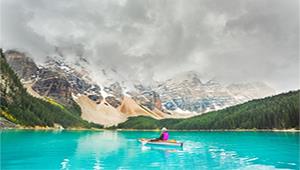Inner Canyon
Most visitors to the park remain content at the top, but many also want to experience the Inner Canyon. There are no roads leading to this section of the park; it's only accessible by boat or vigorous trails.
There's only one non-camping accommodation in the Inner Canyon, which is Phantom Ranch, at the bottom of Bright Angel, South Kaibab and North Kaibab Trails. Get advanced reservations if you plan to stay here.
If you plan to camp in the Inner Canyon, you have to have a backcountry permit--permits generally need to be reserved 4 months in advance and there is a fee. There are multiple choices for backcountry camping, but the most popular options are found along the thoroughfare: Indian Garden (15 sites), Bright Angel (33 sites) and Cottonwood (12 sites).
Raft trips are also an unforgettable way to experience the Inner Canyon, with commercial trips lasting from three days to three weeks. Private trips are also a possibility, but the wait list can be anywhere from 6 to 8 years.
The easiest way to access the Inner Canyon is by hiking.
Hiking
An easy hike along the South Rim, and the most popular walking path in the park, is the 10-mile (one-way) Rim Trail. Starting at Yavapai Museum, this walk will take you all the way to Hermits Rest, shrouding you in the likes of ponderosa and piñon pine, juniper and Gambel oak.
Across the gorge, an easy hike on the North Rim is Transept Trail (1.5 miles) and Cliff Spring Trail (1 mile). These hikes will introduce you to higher-altitude forests, containing Douglas and white fir, Engelmann spruce and aspen. For a more moderate hike you can travel to Point Imperial, offering views of the Little Colorado River gorge and Marble Canyon, or take Cape Royal Trail to get a look at Angels Window, a natural arch formation.
For a more difficult hike on the South Rim, try Hermit Trail, a 9-mile trail that drops about 1,440 feet. This hike will take about one full day to complete.
For the most experienced hikers, you have the trails that lead down to the river. From the South Rim you can begin at Bright Angel Trail or South Kaibab Trail, which starts at Yaki Point; both trails eventually intersect at the river. Bright Angel Trail is 8 miles and drops 4,460 feet. South Kaibab is a little steeper but is only 7 miles. Bright Angel Trail is the most popular route to the Inner Canyon; many people only hike a portion of this trail, turning around at Indian Garden or taking the side trail which leads to Plateau Point--this is where day trips end for mule riders.
From the North Rim there is an even more difficult hike which leads down to the river, North Kaibab Trail. This route drops 5,840 feet and is 14.5 miles long. Bright Angel, South Kaibab and North Kaibab Trails all connect at Phantom Ranch.
Hiking the Grand Canyon is much different than trekking up a standard mountain. This is because at the Grand Canyon you start with the easiest part, the decent. For every hour you move down the canyon, it takes two hours to come back up. Not only that, but the temperature increases the lower you get; temperatures in the Inner Canyon can exceed 100 degrees most summer days. Because of this, it's highly discouraged to attempt getting down and back to the river in one day. Please speak with a ranger about safety precautions before attempting any serious hike, and confirm there is water available along your route. Many people underestimate the difficulty of the trails.
Lastly, be on the lookout for abundant wildlife during your journey. The park is filled with elk, mule deer, mountain lions, bighorn sheep, coyotes, ringtails, tassel-eared squirrels, ravens, jays, chickadees and flickers. There are two endemic species to the park, meaning they only exist there: the Kaibab squirrel (found along the North Rim) and the pink rattlesnake (found at lower elevations).
Camping
There are three developed campsites in the park, all of which allow RVs but have no hookups; they also allow pets if they are leashed at all times. On the South Rim there's Mather Campground, located in Grand Canyon Village, which has 319 sites and takes reservations. This campground is open year-round and is adjacent to Trailer Village, which has full RV hook-ups. Group sites are also available. Desert View Campground is located 26 miles east of Grand Canyon Village, has 50 sites, is not open during the winter, and does not take reservations.
The North Rim has one campground. It is located north of the visitor center and has 78 sites, a tent only area and group sites. Reservations are available and this campground is closed during the winter.
To camp anywhere other than developed campgrounds, a backcountry permit is required.
There are myriad ways to experience Grand Canyon National Park, as it has 80 million years of stories to share. These stories are found painted on the breeze, glimmering off the rocks and within any person who has ever visited the park. So whether you stay on the rim or travel into the depths, all that's required is you come, look, and listen.
 Book your next camping trip
Book your next camping trip
- 2
- of
- 2









Discuss This Article